Occupational Therapy and Neurological Conditions 1st Edition by Jenny Preston, ISBN-13: 978-1118936115
[PDF eBook eTextbook] – Available Instantly
- Publisher: Wiley-Blackwell; 1st edition (May 2, 2016)
- Language: English
- 240 pages
- ISBN-10: 1118936116
- ISBN-13: 978-1118936115
While diagnosis with a neurological condition may not be life-threatening, it can have significant impact on everyday life and on participation in activities. Occupational therapists must be able to fully consider the physical, cognitive, emotional, psychological and behavioural problems which may occur as a consequence of a neurological disorder, and understand the impact of diagnosis from a person-centred perspective. Occupational Therapy and Neurological Conditions incorporates theoretical, clinical and research evidence to support occupational therapists in the management of people with neurological conditions.
- Covers the key symptoms of neurological conditions and the biological basis of these within the ICF framework
- Provides an overview of therapy and management for all neurological conditions
- Includes key occupational therapy theory
- Case studies root concepts in real-life practice
- End-of-chapter self-evaluation questions help test understanding
Occupational Therapy and Neurological Conditions is the ideal resource to support students, newly-qualified practitioners, and occupational therapists looking for an overview or introduction to this key area of practice.
Table of Contents:
Cover
Title Page
List of figures and tables
List of contributors
Academic foreword
Service user foreword
Preface
Acknowledgements
CHAPTER 1: Introduction
1.1 Economic impact of long-term neurological conditions
1.2 Definition of long-term neurological conditions
1.3 International Classification of Functioning, Disability and Health
1.4 Huntington’s disease
1.5 Motor neurone disease
1.6 Multiple sclerosis
1.7 Parkinson’s
1.8 Self-evaluation questions
References
CHAPTER 2: Delivering good quality, safe and effective care
2.1 Introduction
2.2 The strategic context
2.3 Evidence-based practice
2.4 Clinical guidelines
2.5 Practice guidance
2.6 Client expertise in evidence-based practice
2.7 Quality improvement
2.8 Health economic evaluation
2.9 Professional standards of practice
2.10 CPD and lifelong learning
2.11 Self-evaluation questions
References
CHAPTER 3: Person-centredness and long-term neurological conditions
3.1 Introduction
3.2 Person-centredness
3.3 Client-centred practice
3.4 Self-management
3.5 Co-production
3.6 Evaluating your practice
3.7 Self-evaluation questions
References
CHAPTER 4: Theoretical basis
4.1 Introduction
4.2 Definitions of occupational therapy
4.3 Central philosophy of occupational therapy
4.4 Core professional reasoning skills
4.5 Conceptual models of occupational therapy practice
4.6 Frames of reference
4.7 Context-dependent practice skills
4.8 Self-evaluation questions
References
CHAPTER 5: Occupation and long-term neurological conditions
5.1 Introduction
5.2 Defining occupation
5.3 Occupational patterns
5.4 Doing, being, becoming and belonging
5.5 Occupational dysfunction
5.6 Occupational adaptation
5.7 Defining occupational goals
5.8 Self-evaluation questions
References
CHAPTER 6: Identifying occupational performance enablers and deficits
6.1 Introduction
6.2 What is measurement?
6.3 What are occupational therapy outcomes?
6.4 Selecting the right measure
6.5 Commonly used measures in neurological rehabilitation
6.6 Disease-specific measures
6.7 Self-evaluation questions
References
CHAPTER 7: Occupational therapy intervention
7.1 Introduction
7.2 Activities of daily living
7.3 Fatigue management
7.4 Cognitive rehabilitation
7.5 Anxiety management
7.6 Falls management
7.7 Pain management
7.8 Managing tremor
7.9 Sleep
7.10 Sexual relationships and intimacy
7.11 Self evaluation questions
References
CHAPTER 8: Using technology to support participation
8.1 Introduction
8.2 Environmental characteristics and occupational performance
8.3 Environmental adaptations
8.4 Assistive technology
8.5 Assistive devices
8.6 Housing adaptations
8.7 Seating and postural management
8.8 Management of posture and positioning in sitting
8.9 Management of posture and positioning in lying
8.10 Splinting
8.11 Electronic assistive technology
8.12 Self-evaluation questions
References
CHAPTER 9: Living with a long-term neurological condition
9.1 Introduction
9.2 Transitions theory
9.3 Illness experiences
9.4 Rehabilitation and recovery
9.5 Lifespan transitions
9.6 Social and cultural transitions
9.7 Caregiving
9.8 Psychosocial adjustment
9.9 Self-evaluation questions
References
CHAPTER 10: Planning for the future
10.1 Introduction
10.2 Disease progression
10.3 The nature of occupation in death and dying
10.4 Facilitation of meaning, quality of life and well-being
10.5 Spirituality
10.6 Therapeutic use of self
10.7 Advance care planning
10.8 Conclusion
10.9 Self-evaluation questions
References
Index
End User License Agreement
Jenny Preston, PhD, BSc (Hons), DipCOT is a Consultant Occupational Therapist within NHS Ayrshire & Arran, and Glasgow Caledonian University. She has over 30 years clinical experience working with people with a range of neurological conditions, and is currently Chair of the College of Occupational Therapists Specialist Section Neurological Practice.
Judi Edmans, PhD, MPhil, DipCOT, FCOT is a Senior Research Fellow in the Division of Rehabilitation and Ageing at the University of Nottingham. She has been qualified for over 35 years, has worked mainly in stroke both in clinical practice and research and is the editor of the book Occupational Therapy and Stroke.
What makes us different?
• Instant Download
• Always Competitive Pricing
• 100% Privacy
• FREE Sample Available
• 24-7 LIVE Customer Support






Reviews
There are no reviews yet.